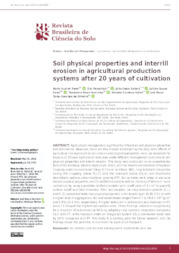Soil physical properties and interrill erosion in agricultural production systems after 20 years of cultivation.
Soil physical properties and interrill erosion in agricultural production systems after 20 years of cultivation.
Author(s): PAVEI, D. S.; PANACHUKI, E.; SALTON, J. C.; SONE, J. S.; ALVES SOBRINHO, T. A.; VALIM, W. C.; OLIVEIRA, P. T. S. de
Summary: Agricultural management significantly influences soil physical properties and soil erosion. However, there are few studies investigating the long-term effects of agricultural management on soil erosion and physical properties. Here, we assessed the impacts of 20-year agricultural land uses under different management practices on soil physical properties and interrill erosion. This study was conducted on an experimental farm of the Embrapa Western Agriculture, Brazil, and the treatments consisted of soybean cropping under conventional tillage (CT) and no-tillage (NT), crop-livestock integration during the cropping phase (CL-C) and the livestock phase (CL-L), and Brachiaria decumbens pasture under rotational grazing (PP). Soil samples were taken to evaluate the soil physical properties, and 25 rainfall simulations with an intensity of 60 mm h-1 were carried out by using a portable rainfall simulator with runoff plots of 0.7 m2 to quantify surface runoff and interrill erosion. After two decades, the crop-livestock systems (CL-L and CL-C) presented better soil physical properties in the topsoil layer (0.00?0.05 m) with a higher level of aggregation. Soil and water losses ranged from 4.7 to 14.4 × 10-3 kg m-2 and 4.9 to 12.4 mm, respectively. A higher reduction in soil erosion was observed in NT, while CT showed the highest soil erosion rates. These findings indicate an opportunity for a reduction of soil erosion by 60 % by adopting crop-livestock integration comparing CL-C with CT, while livestock under an integrated system (CL-L) decreased water loss by 30 % compared with PP. This study is a starting point for future research, and the findings reveal the potential to minimize the agriculture footprint.
Publication year: 2021
Types of publication: Journal article
Observation
Some of Embrapa's publications are published as ePub files. To read them, use or download one of the following free software options to your computer or mobile device. Android: Google Play Books; IOS: iBooks; Windows and Linux: Calibre.
Access other publications
Access the Agricultural Research Database (BDPA) to consult Embrapa's full library collection and records.
Visit Embrapa Bookstore to purchase books and other publications sold by Embrapa.

